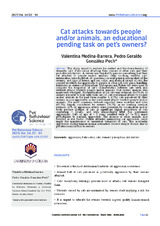Cat attacks towards people and/or animals, an educational pending task on pet’s owners?
Autor
González Pech, Pedro
Medina-Barrera, Valentina
Editor
Universidad de Córdoba, Departamento de Medicina y Cirugía AnimalFecha
2023Materia
AggressionFelis catus
Cats
Owners’ perception
Risk factors
METS:
Mostrar el registro METSPREMIS:
Mostrar el registro PREMISMetadatos
Mostrar el registro completo del ítemResumen
This study aimed to explore the context and the characteristics of domestic cats’ (Felis catus) attacking their owners or other pets and their probable risk factors. A survey was targeted to persons perceiving that their cat attacked to people or/and animals. Only no‑stray, healthy cats’ information were included. 48 questions covered general information of the owners, and type of house; age sex, color, and medical record of cats; the context on which the aggression to people or other pet took place; handling habitudes in owner‑cat interaction. Chi‑square and Fisher test were used to compare the frequency of cat’s characteristics between cats with and without attacks towards people and/or animals. Risk factors analysis was made with WinEpi©. The information of 154 cats was obtained, the 91.5% of owners declared to play with their cats, 63 cats performed attacks to people and/or animals in the past three months. 8 (5.2%) cats perceived by their owners as non‑aggressive, in fact performed attacks towards people and/or animals. The most commons wounds reported were scratches and bites (68.2%), largely considered by owners (76.2%) as no needing medical revision. 62% of aggression events were preceded by vocalization and/or body posture changes of cats. A significant higher proportion of cats combining < 2years, and with nonexclusive litter box performed aggressions. Cats of age of < 2 years resulted with 4.7 to 32.2 more probabilities to perform aggression. The absence of other animals also resulted as risk factor. Owner attitudes minimizing cat aggression could imply the maintenance of unwanted behaviors in cats, also accidental aggression during human‑animal interaction deserve deeper studies due to possible zoonosis risk to owners.

